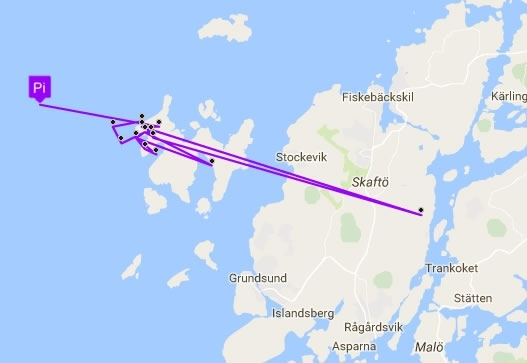By Chris Heward, Wetlands Research Assistant
Pinks was tagged near Bath, Wiltshire in March 2015. That spring, s/he made what we would consider a fairly typical migration, travelling to a breeding site in Western Russia (an area known as the Babayevsky District to be precise). The following winter (2015/16), Pinks' trail went cold and we didn’t receive any data from him/her until April.

Then, unexpectedly, we received data that showed Pinks to be in Sweden. Pinks was on a small island called Gåsö, on Sweden’s West coast north of Gothenburg. The island is part of the Gullmarn Nature Reserve and is only about 2.5 km across.
At first, Pinks’ tag sent an irregular stream of inaccurate data* and we weren’t really sure what to make of it. This was not somewhere we had expected Pinks to be and it seemed possible that there was a fault with the tag. On the other hand, it may be that Pinks was returning to Babayevsky via an unusual route – something that can happen when birds become disorientated in bad weather.
As time passed, more data came through from Gåsö and it looked less and less likely that this was due to a fault with the tag. We received a number of higher-quality fixes that unquestionably put Pinks on Gåsö. What is most surprising is that this continued through the summer. Rather than using this island as a brief stop-over en route to Russia, Pinks has hung around here ever since.
Most woodcock that we have tracked for two summers or more have returned to breed at the same site each year. This is normal, most wading birds show faithfulness to a single breeding area (known technically as ‘philopatry’).
We have also had the odd woodcock that has migrated to the continent in its first spring, but remained at its British wintering site in a subsequent summer. We think that these are probably birds that, for whatever reason, are unfit to migrate and chose not to make the long and arduous journey back to breeding grounds.
What we have not seen until now, however, is a bird migrate to two widely different areas. It’s difficult to work out why Pinks has done this, particularly given the lack of data through the winter but it’s hard to believe that Pinks deliberately chose to change his/her migration route.
It seems likely that Pinks fortuitously stumbled upon Gåsö and decided it looked a suitable breeding site or, perhaps more likely, accidentally arrived here in ill-health and was unable to leave. It will be interesting to see what Pinks does in a couple of months’ time, when we would expect to see our Russian and Scandinavian birds starting their autumn migrations.
*As well as a location, the tags provide an estimate of the data’s accuracy based upon the number of satellites it is contact with and their position in relation to the tagged bird.